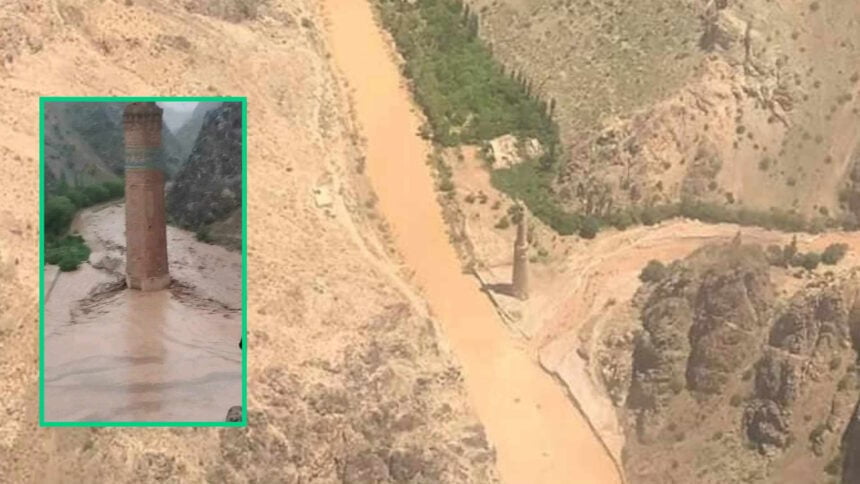Recent heavy rains and floods in Ghor province have endangered the historic Jam Minaret or Minaret of Jam, causing fears of its potential collapse. The minaret is located approximately 70 kilometers east of Firozkoh, the capital of Ghor province.
The Jam Minaret is considered a masterpiece of Ghurid architecture and the oldest brick minaret in the world. It stands 64 meters tall and was constructed 834 years ago. This minaret is not only a symbol of Afghanistan’s rich cultural heritage but also a UNESCO World Heritage site since 2002. It is renowned for its intricate brickwork and Kufic inscriptions, which testify to the Ghurid Empire’s artistic and architectural prowess.
Local sources in Ghor province told Afghan Insight that recent rains and floods have damaged the protective walls surrounding the minaret and are currently impacting its base. Photos shared on social media show that water has reached the edges of this historic structure. The road leading to the minaret, which passes through high mountains, is currently challenging to access, further complicating rescue efforts.
In 2018, when the minaret faced a similar threat from floods, the Afghan government announced severe efforts to save it but did not specify the measures to prevent its collapse. UNESCO also allocated two million Afghanis to restore the minaret in 2019. These efforts, however, seem to have fallen short of providing a lasting solution.
After the Taliban regained power in 2021, they announced their intention to work on the preservation and restoration of the Jam Minaret. Despite numerous reports about efforts to save and restore this historic monument, no significant progress has been made.
Cultural heritage experts have repeatedly stressed the importance of preserving the Jam Minaret, highlighting its historical significance and the urgency of effective conservation measures. The minaret’s remote location, the region’s challenging terrain, and ongoing political instability have made consistent preservation efforts difficult.

In addition to the immediate threat posed by the floods, the minaret has faced other challenges over the years, including looting and neglect. The lack of a comprehensive and sustained conservation plan has left the structure vulnerable to natural and human-induced threats.
International organizations and cultural heritage advocates call for a coordinated effort to safeguard the Jam Minaret. They emphasize that preserving such sites is about protecting a single monument and maintaining a link to Afghanistan’s historical identity and cultural continuity.
The Jam Minaret remains a poignant reminder of Afghanistan’s rich past and the ongoing challenges in preserving its cultural heritage amid adversity. Immediate action and sustained international support are crucial to ensure this architectural marvel is not lost to future generations.





